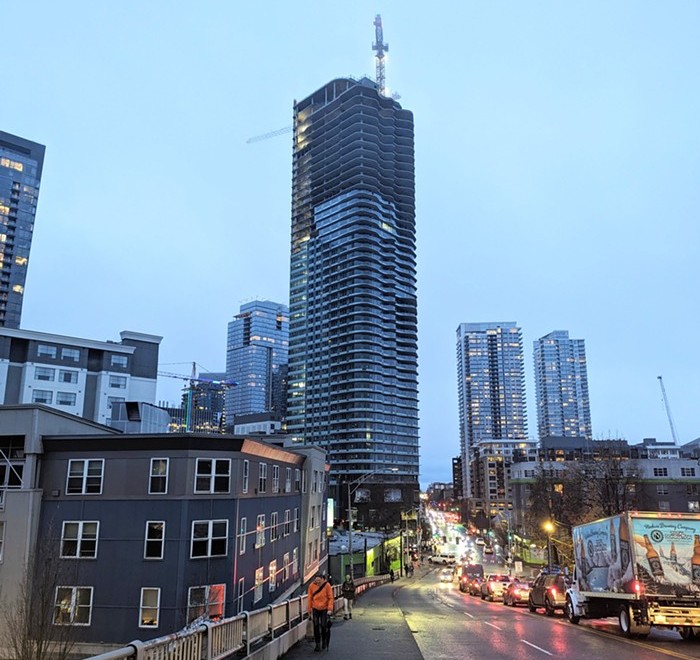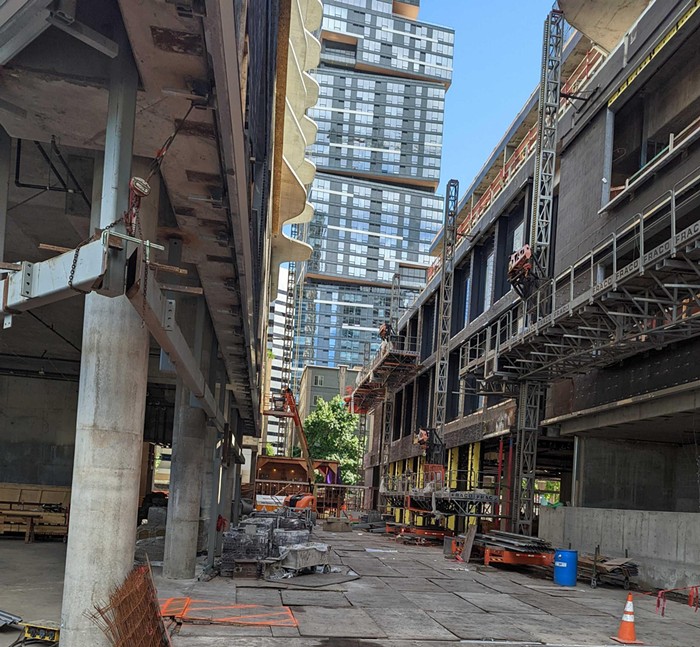
The rubble pictured above amounts to probably the most impressive ever produced during Seattle's nearly decade-long construction boom (or doom, for those feeling Vanishing Seattle). Its existence lasted maybe a week? (The changes of Seattle are hard to keep up with.)
The broken brick and stone came from a neo-Gothic building that coasted indestructibly through almost a century's worth of years. The bold work was completed in 1929; its demolition commenced in June. By the third week of July, all that remained of the church was its three-story tower. In its ghost form, the building is still and will remain a major repository of local memories (I married there, I went to daycare there, I was baptized there).

If you chanced to see this tower before it was reduced to rubble in the last week of July, you would have thought, as I thought, that it was a holdout for the famous monsters of the Gothic realm (Dracula, vampires, Frankenstein). This is where they retreated to as the rest of the church was coming down around them. They wanted to hear nothing about the future, about how the site would become a high-rise for students, and how the church would be reborn at its base. None of that mattered as the monsters defiantly refused to leave. The bats, the coffin, the count.
But a note before I get to the essence of University Temple United Methodist Church's rubble. A line in the opening of this post was inspired by the description of the Combray church in Proust's Remembrance of Things Past.
The church [was] something entirely different from the rest of the town; a building which occupied, so to speak, four dimensions of space—the name of the fourth being Time—which had sailed the centuries with that old nave, where bay after bay, chapel after chapel, seemed to stretch across and hold down and conquer not merely a few yards of soil, but each successive epoch from which the whole building had emerged triumphant...
And now for the essence of the rubble's short-lived greatness, which is composed of two parts; one explained by Lord Kames (his name says everything), and the other by the opening of a short film by the French director/writer/artist Chris Marker.
As regards the former, it is important to understand that the key figures of taste in 18th century England really saw the ruins of Gothic buildings as powerful (if not more powerful) than the actual buildings. In Elements of Criticism (1762), Lord Kames wrote: "Whether should a ruin be in the Gothic or Grecian form? In the former, I think; because it exhibits the triumph of time over strength; a melancholy but not unpleasant thought: a Grecian ruin suggests rather the triumph of barbarity over taste; a gloomy and discouraging thought." There is a lot to unpack in this statement, and this unpacking will certainly not be done in this post. But if you saw the ruins (or, rubble) of the Methodist church during the third week of July, you would have easily grooved with Kames's curious aesthetic position. Visible to all was this "triumph" combined with a "not unpleasant" feeling of "melancholy."
And now, let's turn to, and conclude this brief note with, Chris Marker's La Jetée:

This short film—completed in 1962, composed of stills, inspired the Hollywood blockbuster 12 Monkeys—has a sequence near its opening that attempts to capture the devastation of Paris after the start of the Third World War (it picks up from where America concluded the Second World War, Nagasaki). We see stark images of rubble gripped by the dread-filled music, "Krestu Tvoyemu," of a Russian Orthodox choir. One of these images was of a tower that resembled the one that, for a week, rose above the rubble of the Methodist church.
Dusk was the moment Marker's World War Three became one with what must be Seattle's greatest construction wreckage. As the sun set on that day in July and on downtown Seattle, whose tallest buildings were visible from the destruction site's north side, one could see, as I did see, and feel how a godless world comes to grief.
















